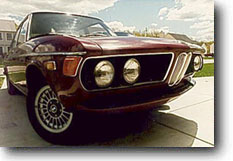

Click on the images for larger shots.
Use your browser's BACK button to return.
by Jim Clark; BMWCCA - #98068, SSR - #35
Then Disaster Struck
The telltale sign was white smoke billowing out of my tail pipe and the temp redline off the gauge! The head gasket had popped. My friend Erick visited me at my home. He took one look at the motor and announced that it was not a genuine Alpina! I was stunned. Erick removed the head and showed me what should have been all of the genuine Alpina motor features. I had been sold a bog standard BMW 3.5 liter.
On the advice of counsel, I will not share anymore of what transpired but I can share with readers what to look for when buying a genuine Alpina car or motor.
Alpina Identification
Two words: Serial Numbers. All Alpina cars and motors have serial numbers. They begin with the letters WAP and usually have a 5 digit number thereafter. On the right inner fender of an Alpina car is a serial number on a riveted plate. The right front strut tower is similarly stamped with this same number. My friend Ufuk Dirim's B10 (Twin Turbo) is shown. (BTW - the fastest four door saloon on the planet).
|
|
 |
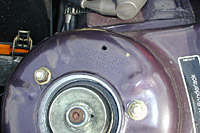 |
|
| Alpina ID Plate on inside fender. | Front strut tower WAP serial number. |
|
|
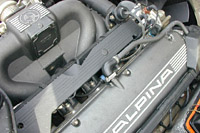 |
|
| Alpina monikers/serials on valve cover and intake runner. |
The head of the motor will have this same serial number. In the case of my purchase, the motor was supposed to have come from an 1984 240hp B9 type or a E28 type BMW. This motor had the normal BMW cast exhaust manifold. I now know that Alpina B9s had headers. Besides the paint scheme, suspension and airdam, other distinctive Alpina features are mostly on the motor's interior; pistons are domed, valves (both intake and exhaust) are larger for improved breathing. Inside the head, Alpina does extensive porting and polishing which smoothes both the intake and exhaust for rapid airflow through the head. The head also receives a radical Alpina camshaft to make all the modifications work together. Finally, the engine management system is modified by Alpina. The DME box is given a new cover and is stamped with the Alpina company logo. Inside the car, an Alpina name plate is found on the dashboard, and the steering wheel, shift lever and finally the seating is striped in Alpina blue and green.
But Back To My Story
Erick told me of the existence of a 1985 M6 motor that had come from a known car which had been in a barn fire. The car was smoky rubbish but the motor was still in fine condition and it's owner, a friend of Erick's, was interested in selling it. Brove was informed of the existence of this motor by me and was urged to acquire the motor on my behalf. Brove did finally buy the M motor and put it in my car. Brove's only commitment was that they would install it and connect it up. Beyond that, NO PROMISES. The cord was cut with Brove.
|
|
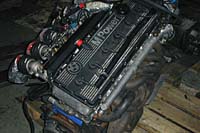 |
|
| Here is the M6 waiting for installation. |
Confident of the motors health, I took the car home and began to acquire more parts to get it installed properly. Make no mistake, this is not an ideal motor for an old Bavaria. One of the positive things you can say about the installation is that it does fit. But things are tight, very tight. The firewall insulation must be removed and that's just for starters! Any old L-Jet or Motronic 3.5 liter is nearly a drop in by comparison. The M motor, with it's enlarged head and intake plenum, is an engineering challenge. But others have done it! There are supposed to be about a dozen such installations in E3 and E9 type cars. Most are located in Germany.
All of this work has been done in the Netherlands, in the southwestern province of Zeeland, by my new mechanic Hans den Dekker. Hans is a one man shop who does general mechanical work and some light body repairs. My car was in Hans' capable hands all winter, during which time he did much of the initial work between his regular daily workload. Later, as many of the engineering problems were flattened, Hans brought in others to help strip out the interior and install new Dynamat sound insulation, underlayment and carpeting.
Technical Issues
Cooling: an M radiator is a must due to BMW's unusual placement of coolant inlets and outlets. To fit all the ancillary cooling system pieces, the coolant overflow tank was re-positioned from the driver's side firewall to the passenger's side behind the headlamp.
|
|
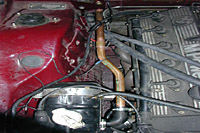 |
|
| Passengers side with relocated coolant tank with copper plumbing. |
Plumbing grade copper tubing was bent and soldered to take coolant from the driver's side of the motor outlet to the tank. This tubing was routed through the trough that brings air to inlet and the heater. It also houses the windshield wiper motor.
Brakes: Again, due to space limitations, the old brake booster must be chucked for virtue of the smaller "brake bomb" type system (actual name; Hydro-Accumulator). What was a pleasant surprise was that the Ate master cylinder from the Bavaria connected right up to the new booster. This made the use of a later model multi-brake line manifold unnecessary.
|
|
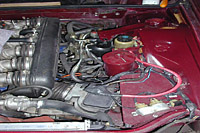 |
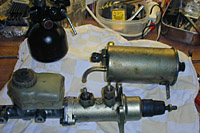 |
|
| Driver's side with Brake Bomb and Air Filter box at fore front. | Brake bits for the Hydro system. |
Air Cleaner: I bought a K&N Filter Charger kit but the position of the AFM forces a custom connection. Hans created an air box that half resides in the wheel well and half in the engine compartment, kind of like on a real M6. This took up most of the space that the battery formerly occupied but does the job elegantly.
|
|
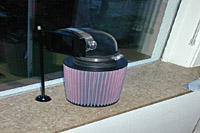 |
|
The K&N system is connected to the AFM mouth via a special 90 degree elbow that protrudes out and downward into Hans' hand-made air box. Some installations of this type often use a simple sponge filter connected to the mouth of the AFM but this encourages too much induction noise. This air box setup quells such noise. The box is ported, and takes cool outside air from behind the driver's side headlamp. The battery was relocated to the trunk with the help of a Summit Racing battery kit.
Gearbox: The Getrag 262/Close Ratio (dog leg left type) 5 speed transmission was removed and sold. It really was a P.I.T.A. to drive around town with my 3.45 rear end. 1st gear was practically useless. I'd usually start out in 2nd gear and go from there. The car now sports a 265/Overdrive type. Fifth gear now spins at 0.81 and drops highway engine rpms by 500@60 mph. Formerly, the old motor turned at 2900 at 60mph which was a little too high. In fact, it was probably the 262/CR type gearbox that falsely made the car feel like it had the 40 extra Alpina horses and much more torque. The 265/OD should make for better fuel economy but also imbue the car with a more relaxed highway and around town manners and a top speed of well over 150mph. To aid the connection of the tranny to the motor, a Motronic-era bell housing with special engine management sensors was necessary. Erick got me this item. In deference to M Power torque, this new gearbox was installed with another of Metric Mechanic's tweeks; The MM HiTorque Crossmember with dual rubber mounts as well as a MM shift bracket mounting kit.
|
|
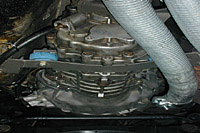 |
|
| Metric Mechanic tranny brace and flexi-exhaust. |
This burly steel bracket spans the transmission tunnel and cinches the gearbox to the car with two tranny mounts (E3 type cars normally have only one mount). I think it worth every penny.
Exhaust: The stock exhaust was deemed too restrictive and Hans went about creating a new system from separate Bosal components. Downward from the stock M6 headers are two flexible pipes that travel in parallel to the car's centerline and into the resonator. From the resonator, dual pipes enter a 535i muffler. Normally, this muffler has twin tail pipes. Hans removed the Bav's original S-shaped tailpipe from the old muffler and welded it to, and in lieu of, the 535i twins. In this way, the exhaust exits the Bav's rear lower body valance normally and keeps the car's stock appearance. The resulting sound is mildly louder than original but much deeper, throatier.
|
|
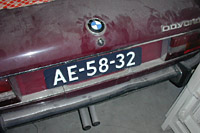 |
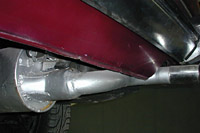 |
|
| 535i Exhaust tips before Bav tailpipe added. | OE Bavaria tail pipe grafted onto 535i muffler. |
|
|
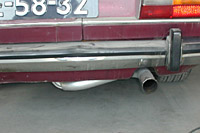 |
|
| Exhaust after tailpipe added. |
Usage
Delivery: Upon delivery from Hans, I took the car out on the open road and gradually increased it's speed and used it's brakes more aggressively. The car aches to go faster but I won't take it up to anything near it's capability without several weeks of moderate use to be sure the brakes are up to snuff. But I can say that the handling seems fine, even though the M motor is 80 lbs. heavier than the original carbureted three liter.
Tires: I went out and bought some new shoes too. I bought some Michelin Pilot Sports. I have found these tires to be excellent. Mated to the 16” Alpina wheels, I was able to provide the car with the traction that the motor deserved. On the front are 16/55/205 and at the rear are 16/50/225. No rubs and no scuffs. These tires are excellent! Quiet with great cornering ability.
Future and Thanks
As the summer progresses, I will get my air conditioning sorted and my front and rear seats recovered. Later, I expect to have Hans prepare the car for a new paint job as I intend to keep the original Malaga paint. The beltline trim will be removed and all places, where hidden rust might reside, will be opened, inspected and any rust eradicated.
As an aside, as negative as my experience was with the non-Alpina motor, my experience was very positive with some new Dutch friends that took pity on me and helped get my car going again. Bedankt, mijn vrienden. And as always, thanks to my cohorts within The Senior Six Registry (keep your dues up to date) and from several kind souls from the Coupe Registry who not only offered condolences and legal advise but shared technical assistance to get this car to rise from the ashes.
Too bad it's a Bav? Nee, mijn M kracht Bavaria is lekker.
Jim Clark can be reached at airbav@xs4all.nl
Summit Racing +1 (800) 230-3030
Bavarian Autosport (800) 535-2002
Metric Mechanic +1 (816) 231-0604
Senior Six Registry http://www.seniorsix.org